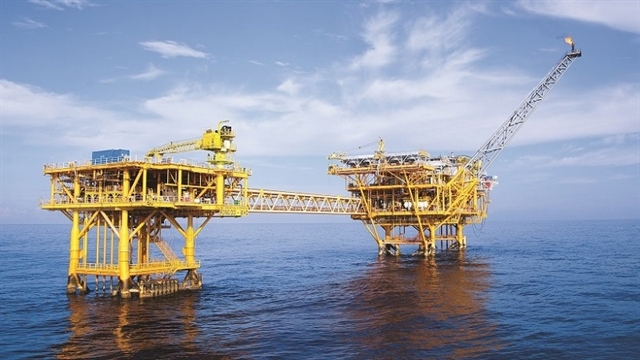 Economy
Economy

 |
| Illustrative Photo |
HÀ NỘI — The Government on April 3, 2023 issued Resolution No.48/NQ-CP, approving the Strategy for Sustainable Exploitation and Use of Resources, and the Protection of the Marine & Island Environment until 2030, with a vision towards 2050.
One of the specific objectives outlined in the strategy is the rapid and sustainable development of the oil and gas industry.
The overall goal set for the year 2030 in the strategy is the rational, fair, and efficient exploitation and utilisation of marine and island resources to serve socio-economic development, while still ensuring national defence, security, foreign affairs, and international cooperation. Efforts will be made to prevent, control, and significantly reduce marine environmental pollution.
Marine biodiversity, coastal areas, and islands will be protected, maintained, and restored. The values of natural heritage and maritime cultural heritage will be preserved and promoted. The impacts of natural disasters will be minimised, and effective proactive measures will be taken to address climate change and sea-level rise, with the aim of making Việt Nam a strong, prosperous maritime nation.
Rapid, sustainable development of key sea economic sectors
The specific objectives for 2030 are as follows: The marine and island resources will be rationally exploited and efficiently utilised to achieve rapid and sustainable development in key marine economic sectors and coastal areas, with the following priority order: (1) Tourism and marine services; (2) Maritime economy; (3) Oil and gas exploitation and other marine mineral resources; (4) Aquaculture and fisheries exploitation; (5) Coastal industry; (6) Renewable energy and emerging marine economic sectors, improving the livelihoods of coastal communities.
Basic surveys and scientific research on marine and island resources are expected to 'basically' meet the requirements of sustainable resource exploitation and use, environmental protection, preservation of marine and island biodiversity, preservation and promotion of maritime cultural heritage, disaster prevention and response, and adaptation to climate change and sea-level rise, contributing to the sustainable development of the marine economy.
The potential and value of important marine resources will be fully assessed. At least 50 per cent of the maritime area of Việt Nam will be surveyed for resources and environmental information at a scale of 1:500,000, and detailed surveys will be conducted in some key areas. An integrated information system on resources and the marine environment will be established, ensuring integration, sharing, and updating of information.
The vision for 2050 is the rational exploitation and efficient utilisation of marine and island resources, aiming to make Việt Nam a strong maritime nation based on green growth, preserving marine biodiversity, and ensuring a clean marine environment and healthy islands, creating a harmonious society with nature.
Sustainable exploitation and use of marine and island resources
One of the tasks of the Strategy is the sustainable exploitation and use of marine and island resources. Marine and island resources include living and non-living resources in the seawater, on the seabed, in the subsoil beneath the seabed, in the land of coastal areas, archipelagos, islands, submerged banks under the sovereignty, sovereign rights, and jurisdiction of Việt Nam.
Developing coastal industrial parks, coastal economic zones, as well as islands with high-tech industries, foundational technologies, and source technologies. Striving for an average annual increase of 20 per cent in the number of enterprises implementing technological innovations. Developing renewable energy and environmentally-friendly emerging marine economic sectors, ensuring that the proportion of renewable energy in primary energy consumption reaches 32.3 per cent.
Prioritising resources to promote environmentally-friendly, efficient resource exploitation and utilisation models, projects that meet the criteria of circular economy, in line with the resource reserves and ecological carrying capacity. Limiting resource exploitation and utilisation through outdated and inefficient technologies that cause resources damages, environmental pollution, and biodiversity loss.
By 2030, 80 per cent of coastal areas to exhibit high level of biodiversity
Another task of the Strategy is the conservation of biodiversity and marine and island resources. Protecting and maintaining existing conservation areas; surveying, assessing, and proposing the establishment of new conservation areas in coastal, marine, and island areas; enhancing biodiversity conservation outside of conservation areas; restoring degraded marine and coastal ecosystems.
By 2030, the area of marine and coastal conservation areas should reach a minimum of 6 per cent of the natural area of the national maritime zone, with 80 per cent of coastal areas exhibiting high level of biodiversity. Effective policies on payment for ecosystem services will be applied, and the area of mangrove forests in coastal areas will be restored to at least the level recorded in the year 2000.
To achieve the above-mentioned goals and tasks, the Strategy outlines key solutions, including: improving the legal system for resource management and marine and island environmental protection; developing science and technology; proactively strengthening and expanding international cooperation in the management and research of marine and island environment and resources; promoting education, training, and development of marine human resources; establishing sustainable financial mechanisms in service of sustainable exploitation and utilisation of marine and island resources; building a national information system and database marine and island environment and resources. — VNS